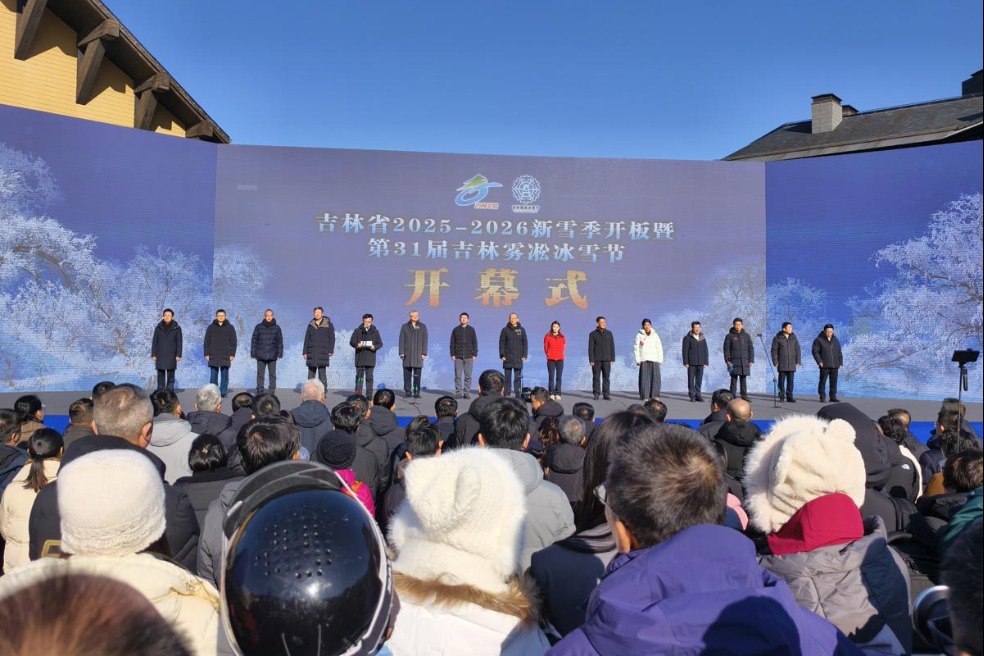Tussling for spenders

Hong Kong and Shenzhen are in a battle of a different kind: The two neighboring cities are wrestling for post-pandemic consumers to spur an economic recovery that hasn't gone as fast as expected. Zhang Tianyuan reports from Hong Kong.

Hong Kong is fighting an uphill battle to get its residents to stay where they are and boost sagging local consumption amid an irresistible trend of "heading north" to take advantage of growing affordability on the Chinese mainland - a trend fueled by a depreciating yuan and a greater appeal to tourists.
The special administrative region is trying to turn it around by revamping the city's nightlife and bolstering art and cultural attractions to make the "Pearl of the Orient" shine again after more than three years of COVID-19 weariness.
Lin Zhiyi, a student of the University of Hong Kong, is not missing out on the trend. She's among tens of thousands of Hong Kong residents flocking each weekend to Shenzhen - a bustling city just across the Shenzhen River in Guangdong province - and this has become a cherished part of her holiday routine. She packs the two-day getaway with dining, shopping and going to the movies - not just to escape from jam-packed Hong Kong or pressure of work, but because she sees it as a "weekly necessity".
"I was in Shenzhen just a couple of days ago with friends, having hotpot meals and shopping in the Luohu district. We spent just 150 yuan ($20.46) each for lunch," she said, pointing out it would cost each person an average of 250 yuan at a notable hotpot restaurant in the SAR.
The main reason for Lin's heading north at least twice a week is simple - it's more cost-effective for a student like her. After a meal, they would take a taxi, costing them 6 yuan each, to a nearby popular shopping mall, to be followed by a round of milk tea, shopping, and a three-hour private karaoke session - all for an average cost of 80 yuan per person.
To stay for the night, an above-average-class hotel in Shenzhen sets them back about 250 yuan each, complete with robot-assisted room service and self-service laundry facilities. The lure of Shenzhen's affordability, combined with its vibrant offerings, has made the city irresistible for Hong Kong residents.

'Revenge shopping'
According to the SAR's Immigration Department, the total number of trips to the mainland by Hong Kong residents between July 1 and Aug 29 reached 9 million. Total expenditures there could have reached HK$4 billion ($511 million) in July alone.
The number of transactions in the second quarter involving Hong Kong tourists who use AlipayHK on the mainland was three times the volume recorded in the previous quarter.
A Hong Kong media professional surnamed Mok said he spends two or three days in Shenzhen monthly for social gatherings and gaming. "I went there for indoor go-karting with a friend at a shopping mall in Longgang district last week. It cost 256 yuan for unlimited access to all the facilities within the sprawling playground, including go-kart racing, bowling and snow-skating for the whole day. In Hong Kong, a similar game experience in kart race would cost about HK$210, with only eight minutes for the game."
Shenzhen has undergone a rapid transformation in the past four decades following the nation's reform and opening-up, evolving into a megacity with gleaming shopping malls packed with luxury brands, as well as low-cost goods. Visitors can enjoy not only the city's cutting-edge infrastructure, but also services and products tailor-made for Hong Kong's working class and students.
The reopening of the Hong Kong West Kowloon terminus of the Guangzhou-Shenzhen-Hong Kong high-speed rail link following the COVID-19 pandemic has significantly boosted passenger traffic at Shenzhen's land ports linking the SAR. This has partly contributed to a substantial increase in the southern mainland city's consumer spending power. Hong Kong travelers are now able to reach Shenzhen in about 20 minutes by high-speed rail.
"Many Hong Kong residents haven't gone to the mainland for years due to the pandemic. So they are now flocking to Shenzhen for 'revenge shopping' to make up for the time lost," said Chong Tai-leung, associate professor at the Chinese University of Hong Kong's Department of Economics.
"It's no longer confined to just one or two people going to Shenzhen each weekend. Whole families are going there together. This structural shift will continue to gain momentum," he said.
Ivan Chu Siu-lun said he had gone to Guangdong with his two children three times during this summer vacation, visiting Shunde, Panyu and Shenzhen. "My children have a special liking for tanghulu - a favorite street fruit snack on the mainland. Amusement parks there are also bigger with more comprehensive facilities, compared to those in Hong Kong."
When it comes to taste and variety of Chinese food, Shenzhen's cuisine has an "unequivocal advantage" over Hong Kong's, said Chu, who is also a member of the Chinese Association for Hong Kong and Macao Studies.
Citing suan cai yu - a Sichuan dish with white fish fillets, pickled vegetables and red chiles - the names of more than 600 restaurants in Shenzhen appear once a consumer types the name of that dish in the search box of the restaurant-review app Dazhong Dianping. "In Shenzhen, you can find any type of food anywhere, and the prices are much cheaper than those in Hong Kong," he said.
Calvin Tang Siu-fung, who works in the public sector, said that although the mainland's consumption power has grown stronger, Hong Kong residents can still obtain more and better services, as well as commodities, for the same amount of money in Hong Kong because of the mainland's lower rents and labor costs.
In addition, the recent depreciation of the Chinese yuan is expected to further boost Hong Kong consumers' spending power in Shenzhen, said Tang, who is also a chartered financial analyst. The yuan has lost more than 5 percent of its value against the dollar so far this year - to 7.33 per dollar as of Sept 8.
Meanwhile, Hong Kong's private consumption - one of the major growth engines of the city's economy - faces challenges arising from the changing spending habits of tourists and residents who visit the mainland frequently.

Shift in demand
Financial Secretary Paul Chan Mo-po said tourists now seek cultural experiences, art exhibitions and large-scale concerts in Hong Kong. The government plans to launch night bazaars as part of an effort to revitalize the economy, which is expected to expand 4 to 5 percent this year, compared to an initial projected gross domestic product growth rate of 3.5 to 5.5 percent.
Hong Kong's private consumption slowed down in the second quarter of this year, with its year-on-year growth rate declining to 8.2 percent from the previous quarter's expansion of 13 percent. Restaurant receipts recorded an increase of 24.3 percent year-on-year from April to June, following an 81.8 percent surge in the preceding quarter.
Allan Zeman, dubbed the "King of Lan Kwai Fong" - the city's famed nightlife district - said Hong Kong needs to nurture a unique cultural identity to draw tourists, noting that mainland visitors are no longer as enthralled by shopping malls as they were in the past. "Any type of shopping mall we see in Hong Kong can also be seen in every city on the mainland," he said.
Lan Kwai Fong - an iconic must-go venue that comes to life after sunset - is one of Hong Kong's potent cultural symbols. Defying the tepid business trend of local restaurants, the nightspot remains a party center, with music blaring from open-air bars, and its streets swarming with beer-loving tourists and locals alike.
Zeman said Lan Kwai Fong's fame and fortune are driven partly by the influx of young mainland tourists keen to "experience something different", be it flipping through English-language menus and getting lost in the terminology of exotic cuisine, or pointing at the names of cocktails without daring to try to pronounce them. He said the nightspot's "uniqueness" had helped Lan Kwai Fong Group achieve a 20 percent year-on-year increase in revenue in August. "Mainland tourists spent much more before the pandemic."
Zeman said Hong Kong must strive for a world-class approach when organizing night bazaars. "Inspired by the likes of Singapore and Taiwan, let's ensure we do it with utmost excellence. Our goal should be to create an impactful experience, setting it apart from ordinary markets." He said local restaurants should offer customers more al fresco dining options, citing it as a crucial element that contributes to the city's cultural atmosphere.
Henry Ho Kin-chung, founder and chairman of the local think tank One Country Two Systems Youth Forum, suggested Hong Kong formulate strategies to retain local customers and attract mainland tourists, particularly those from Guangdong.
The SAR should draw inspiration from mainland cities, focusing on key areas such as improving the quality of services and digitizing the customer experience. The mainland's technology industry has transformed the way consumers shop, hail taxis and order takeout meals, while Hong Kong started embracing these advancements relatively late.
"For example, people are able to scan QR codes while queuing up at restaurants," Ho said. "Hong Kong's high rental costs have restricted options in large shopping malls predominantly filled with international luxury brands, while mainland cities in the Guangdong-Hong Kong-Macao Greater Bay Area boast a vibrant retail scene with a plethora of small and medium-sized enterprises and dynamic small shops run by young folks."
Chu said that Hong Kong's tourism sector is acutely short of manpower, increasing the workload on employees in the industry. The long and demanding hours also make it challenging for them to provide exceptional services for tourists.
He hoped the local business format could be overhauled to catch up with the mainland's modernized systems.
"Mainland customers already enjoy the convenience of services like Didi's - a mobility platform that provides ride hailing and other related services - offering affordable prices and excellent benefits."
Contact the writer at tianyuanzhang@chinadailyhk.com
- Mystery of sticky lunar soil solved
- Blueprint put Fuzhou on track for transformation
- Report on Shenzhen-Jiangmen railway collapse documents regulation violations
- GX Foundation opens its global headquarters in Hong Kong
- China's success in development empowers Global South
- Study explains why Chang'e 6 moon soil is unexpectedly sticky




































